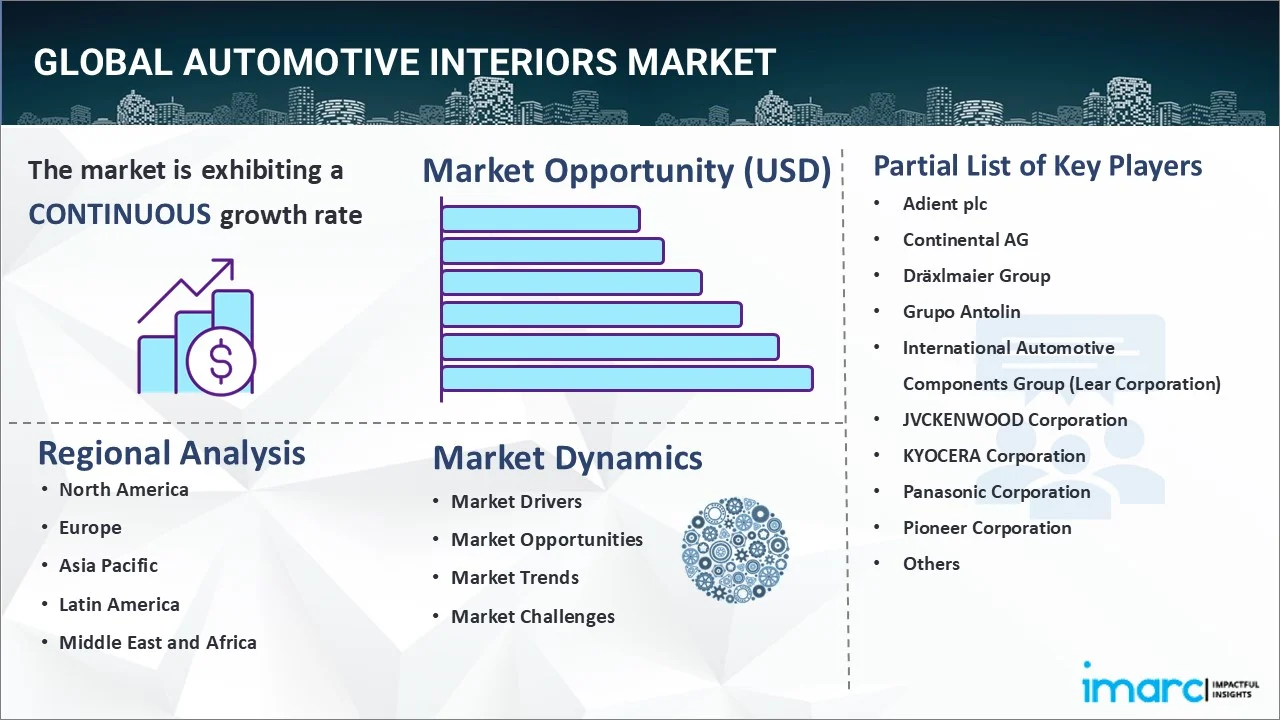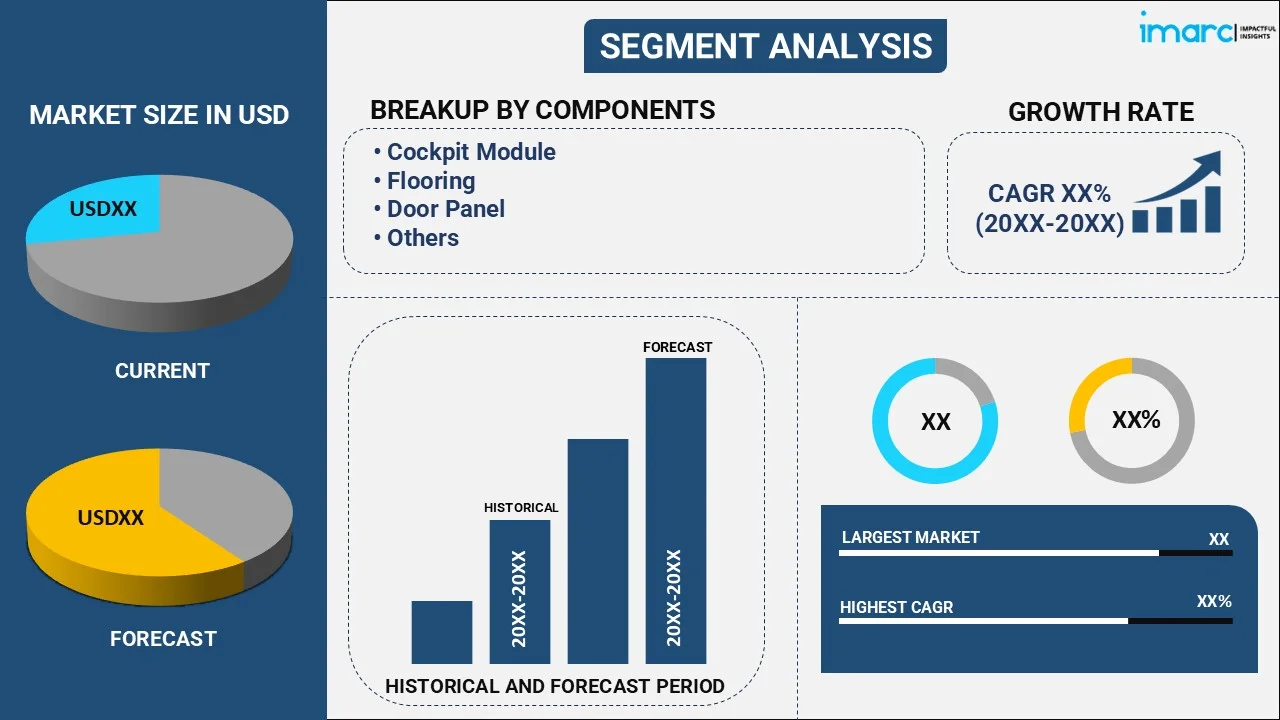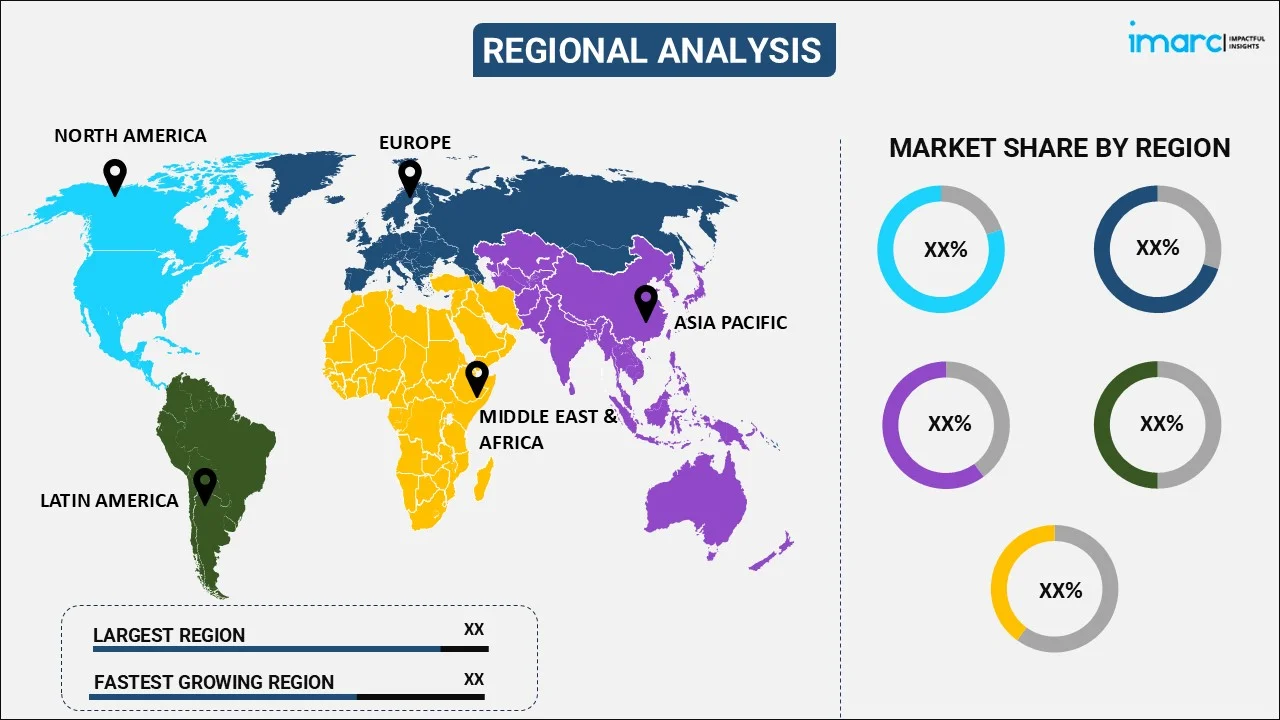
Automotive Interiors Market Report by Component (Cockpit Module, Flooring, Door Panel, Automotive Seat, Interior Lighting, and Others), Material (Leather, Fabric, Vinyl, Wood, Glass Fiber Composite, Carbon Fiber Composite, Metal), Vehicle Type (Passenger Cars, Commercial Vehicles), and Region 2025-2033
Global Automotive Interiors Market:
The global automotive interiors market size reached USD 165.4 Billion in 2024. Looking forward, IMARC Group expects the market to reach USD 235.1 Billion by 2033, exhibiting a growth rate (CAGR) of 4% during 2025-2033. The increasing consumer demand for enhanced comfort and luxury features in vehicles drives interior design innovations, which is stimulating the market. Presently, Asia Pacific accounted for the largest market share, owing to the rising investments in R&D activities by leading manufacturers and the elevating sales of automobiles.
|
Report Attribute
|
Key Statistics |
|---|---|
|
Base Year
|
2024 |
|
Forecast Years
|
2025-2033 |
|
Historical Years
|
2019-2024
|
| Market Size in 2024 | USD 165.4 Billion |
| Market Forecast in 2033 | USD 235.1 Billion |
| Market Growth Rate 2025-2033 | 4% |
Automotive Interiors Market Analysis:
- Major Market Drivers: The growing focus on advanced technology integration, such as infotainment systems, connectivity, and AI, drives the market growth.
- Key Market Trends: The rising emphasis on sustainability encourages the use of eco-friendly materials in automotive interior production, which is acting as a growth-inducing factor.
- Competitive Landscape: Some of the major market companies include Adient plc, Continental AG, Dräxlmaier Group, Grupo Antolin, International Automotive Components Group (Lear Corporation), JVCKENWOOD Corporation, KYOCERA Corporation, Panasonic Corporation, Pioneer Corporation, Robert Bosch GmbH, Toyota Boshoku Corporation, and Yanfeng Automotive Interior Systems Co. Ltd., among many others.
- Geographical Trends: Rapid urbanization, disposable incomes, and the increasing consumer preference for advanced technology and luxury features in vehicles are augmenting the market in Asia-Pacific.
- Challenges and Opportunities: The high cost of premium materials is hindering the market. However, investing in sustainable alternatives that balance quality and affordability will continue to catalyze the market over the forecasted period.

Automotive Interiors Market Trends:
Growing Consumer Preference for Sustainable Materials
Consumers are increasingly prioritizing eco-friendly options, driving automotive interiors manufacturers to explore sustainable materials, such as recycled plastics and natural fibers. In contrast, this shift not only addresses environmental concerns but also enhances brand appeal by aligning with the values of environmentally conscious buyers. For instance, in April 2024, Antolin showcased innovative sustainable solutions at the Beijing International Auto Show, featuring a headliner made from recycled materials, next-gen natural fiber products, and customizable components. Therefore, emphasizing their commitment to eco-friendly automotive interiors and reducing environmental impact throughout the product lifecycle.
Increasing Demand for Advanced Safety Features
There is a rising expectation for advanced safety technologies within automotive interiors. Moreover, features such as next-generation airbags, active seat belts, and integrated safety systems are becoming essential as consumers seek vehicles that prioritize occupant protection and comply with stringent safety regulations, thereby ultimately influencing purchasing decisions. For instance, in June 2024, ZF LIFETEC introduced next-generation airbags, steering wheels, and active seat belts, enhancing vehicle interior safety. These innovations include a seamless steering wheel design and advanced occupant protection systems, reflecting a commitment to improved safety standards and innovative interior solutions in modern vehicles. This, in turn, is propelling the automotive interiors market share.
Rising Interest in Personalized Interior Designs
Customization is gaining traction as consumers desire unique and tailored experiences in their vehicles. Furthermore, this trend encourages manufacturers to offer diverse design options and finishes, allowing buyers to express their individuality and preferences. Thus, enhancing overall satisfaction with their vehicle's interior space. For instance, in March 2024, Hyundai revealed the interiors of the Creta N Line, featuring an all-black cabin design enhanced with red inserts. This model aims to attract buyers with its sporty aesthetic, including 'N' badging on the gear knob and steering wheel, while retaining the standard layout.
Global Automotive Interiors Industry Segmentation:
IMARC Group provides an analysis of the key trends in each segment of the market, along with forecasts at the global, regional, and country levels for 2025-2033. Our report has categorized the market based on component, material, and vehicle type.
Breakup by Component:

- Cockpit Module
- Flooring
- Door Panel
- Automotive Seat
- Interior Lighting
- Others
Automotive seat currently dominates the market
The report has provided a detailed breakup and analysis of the market based on the component. This includes cockpit module, flooring, door panel, automotive seat, interior lighting, and others. According to the report, automotive seat represented the largest market segmentation.
Automotive seats lead the automotive interiors market, driven by advancements in comfort, safety features, and ergonomic designs. In contrast, innovations in materials and customization options further enhance their appeal to consumers.
Breakup by Material:
- Leather
- Fabric
- Vinyl
- Wood
- Glass Fiber Composite
- Carbon Fiber Composite
- Metal
The report has provided a detailed breakup and analysis of the market based on the material. This includes leather, fabric, vinyl, wood, glass fiber composite, carbon fiber composite, and metal.
Leather, fabric, vinyl, wood, glass fiber composites, carbon fiber composites, and metal are essential materials used in automotive interiors. Apart from this, each material enhances aesthetics, comfort, durability, and sustainability, contributing to an elevated driving experience and modern vehicle design.
Breakup by Vehicle Type:
- Passenger Cars
- Commercial Vehicles
Passenger cars currently hold the largest market outlook
The report has provided a detailed breakup and analysis of the market based on the vehicle type. This includes passenger cars and commercial vehicles. According to the report, passenger cars represented the largest market segmentation.
Passenger cars lead in the automotive interiors sector, driven by consumer demand for comfort, advanced technology, and personalization options that enhance the overall driving experience.
Breakup by Region:

- North America
- United States
- Canada
- Asia-Pacific
- China
- Japan
- India
- South Korea
- Australia
- Indonesia
- Others
- Europe
- Germany
- France
- United Kingdom
- Italy
- Spain
- Russia
- Others
- Latin America
- Brazil
- Mexico
- Others
- Middle East and Africa
Asia-Pacific currently dominates the market
The market analysis report has also provided a comprehensive analysis of all the major regional markets, which include North America (the United States and Canada); Asia Pacific (China, Japan, India, South Korea, Australia, Indonesia, and others); Europe (Germany, France, the United Kingdom, Italy, Spain, Russia, and others); Latin America (Brazil, Mexico, and others); and the Middle East and Africa. According to the report, Asia-Pacific accounted for the largest market share.
As per the market research report, Asia-Pacific leads the market, driven by rapid urbanization, rising disposable incomes, and increasing consumer preference for advanced technology and luxury features. Moreover, the Kia EV6 and Hyundai Creta N Line showcase innovative interior designs and high-tech features, appealing to consumers seeking comfort and modern aesthetics in their vehicles. This trend underscores the region's dynamic automotive landscape and growing demand for interiors.
Competitive Landscape:
The market research report has provided a comprehensive analysis of the competitive landscape. Detailed profiles of all major market companies have also been provided. Some of the key players in the market include:
- Adient plc
- Continental AG
- Dräxlmaier Group
- Grupo Antolin
- International Automotive Components Group (Lear Corporation)
- JVCKENWOOD Corporation
- KYOCERA Corporation
- Panasonic Corporation
- Pioneer Corporation
- Robert Bosch GmbH
- Toyota Boshoku Corporation
- Yanfeng Automotive Interior Systems Co. Ltd.
(Please note that this is only a partial list of the key players, and the complete list is provided in the report.)
Automotive Interiors Market Recent Developments:
- July 2024: Mahindra & Mahindra introduced the Thar Roxx, a five-door variant featuring updated interiors with a new steering wheel, a 10.25-inch touchscreen, advanced safety features, and two sunroof options.
- April 2024: Kia Europe and Bcomp unveiled sustainable interior designs for the Concept EV3 and EV4. This collaboration emphasizes eco-friendly materials and innovative solutions, aiming to revolutionize automotive interiors while addressing environmental concerns.
- March 2024: Hyundai revealed the interiors of the Creta N Line, featuring an all-black cabin design enhanced with red inserts.
Automotive Interiors Market Report Scope:
| Report Features | Details |
|---|---|
| Base Year of the Analysis | 2024 |
| Historical Period | 2019-2024 |
| Forecast Period | 2025-2033 |
| Units | Billion USD |
|
Scope of the Report |
Exploration of Historical Trends and Market Outlook, Industry Catalysts and Challenges, Segment-Wise Historical and Predictive Market Assessment:
|
| Components Covered | Cockpit Module, Flooring, Door Panel, Automotive Seat, Interior Lighting, Others |
| Materials Covered | Leather, Fabric, Vinyl, Wood, Glass Fiber Composite, Carbon Fiber Composite, Metal |
| Vehicle Types Covered | Passenger Cars, Commercial Vehicles |
| Regions Covered | Asia Pacific, Europe, North America, Latin America, Middle East and Africa |
| Countries Covered | United States, Canada, Germany, France, United Kingdom, Italy, Spain, Russia, China, Japan, India, South Korea, Australia, Indonesia, Brazil, Mexico |
| Companies Covered | Adient plc, Continental AG, Dräxlmaier Group, Grupo Antolin, International Automotive Components Group (Lear Corporation), JVCKENWOOD Corporation, KYOCERA Corporation, Panasonic Corporation, Pioneer Corporation, Robert Bosch GmbH, Toyota Boshoku Corporation, Yanfeng Automotive Interior Systems Co. Ltd., etc. |
| Customization Scope | 10% Free Customization |
| Post-Sale Analyst Support | 10-12 Weeks |
| Delivery Format | PDF and Excel through Email (We can also provide the editable version of the report in PPT/Word format on special request) |
Key Benefits for Stakeholders:
- IMARC's industry report offers a comprehensive quantitative analysis of various market segments, historical and current market trends, market forecasts, and dynamics of the automotive interiors market from 2019-2033.
- The research report provides the latest information on the market drivers, challenges, and opportunities in the global automotive interiors market.
- The study maps the leading, as well as the fastest-growing, regional markets. It further enables stakeholders to identify the key country-level markets within each region.
- Porter's five forces analysis assists stakeholders in assessing the impact of new entrants, competitive rivalry, supplier power, buyer power, and the threat of substitution. It helps stakeholders to analyze the level of competition within the automotive interiors industry and its attractiveness.
- The competitive landscape allows stakeholders to understand their competitive environment and provides insight into the current positions of key players in the market.
Key Questions Answered in This Report
The global automotive interiors market was valued at USD 165.4 Billion in 2024.
We expect the global automotive interiors market to exhibit a CAGR of 4% during 2025-2033.
The sudden outbreak of the COVID-19 pandemic had led to the implementation of stringent lockdown regulations across several nations, resulting in temporary closure of numerous manufacturing units for various automotive interiors.
The rising demand for luxurious vehicles, along with the increasing integration with several premium features, such as AI-enabled entertainment systems and GPS for ensuring advanced safety arrangements, is primarily driving the global automotive interiors market.
Based on the component, the global automotive interiors market has been segmented into cockpit module, flooring, door panel, automotive seat, interior lighting, and others. Among these, an automotive seat currently holds the majority of the total market share.
Based on the vehicle type, the global automotive interiors market can be divided into passenger cars and commercial vehicles. Currently, passenger cars exhibit a clear dominance in the market.
On a regional level, the market has been classified into North America, Asia-Pacific, Europe, Latin America, and Middle East and Africa, where Asia-Pacific currently dominates the global market.
Some of the major players in the global automotive interiors market include Adient plc, Continental AG, Dräxlmaier Group, Grupo Antolin, International Automotive Components Group (Lear Corporation), JVCKENWOOD Corporation, KYOCERA Corporation, Panasonic Corporation, Pioneer Corporation, Robert Bosch GmbH, Toyota Boshoku Corporation, and Yanfeng Automotive Interior Systems Co. Ltd.
Need more help?
- Speak to our experienced analysts for insights on the current market scenarios.
- Include additional segments and countries to customize the report as per your requirement.
- Gain an unparalleled competitive advantage in your domain by understanding how to utilize the report and positively impacting your operations and revenue.
- For further assistance, please connect with our analysts.
 Request Customization
Request Customization
 Speak to an Analyst
Speak to an Analyst
 Request Brochure
Request Brochure
 Inquire Before Buying
Inquire Before Buying




.webp)




.webp)












